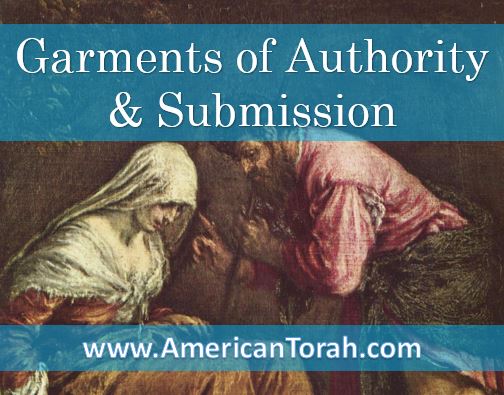
Now Israel loved Joseph more than any other of his sons, because he was the son of his old age. And he made him a robe of many colors.
Genesis 37:3 ESV
Although Moses did not tell us so, I am certain that this garment was not simply a coat, but a mantle like Elijah’s, a badge of office and an emblem of divinely delegated authority. I also suspect that it was made in exactly twelve colors, one for each of the tribes of Israel over which Joseph would be given authority. Recall that the High Priest’s breastplate, as well as the foundations and the gates of the New Jerusalem, contained twelve precious stones of twelve different colors explicitly representing the twelve tribes. It was an independent confirmation of the prophecy which Joseph was soon to receive in a dream.
This Torah portion (Vayeshev, Genesis 37-40) is full of clothes and head coverings.
- Reuben tore his clothes (Genesis 37:29)
- Joseph’s brother dipped his robe in blood and presented it to their father (Genesis 37:33)
- Jacob tore his garments (Genesis 37:34)
- Tamar removed her widow’s garments and donned a veil (Genesis 38:14-15)
- Tamar removed her veil and donned widow’s garments (Genesis 38:19)
- Potiphar’s wife caught Joseph by his garment and used it to frame him (Genesis 39:12-16)
- Pharaoh’s baker dreamed of three baskets on his head (Genesis 40:16-19)
Garments and coverings of all kinds are prominent throughout Scripture and almost always have a deeper meaning than what can be read only on the surface.
For example, when Moses came down from Mt. Sinai, his face glowed and he wore a veil over his face to hide the glory of it from the Israelites. (Exodus 34:29-35) I was taught that this was a purely pragmatic act, that he had absorbed so much of God’s glory that nobody could stand to look at it, but I think that’s only partly correct.
When Moses was engaged in God’s business–for example, when he spoke the Torah to the assembled Israelites and when he was in the tent communing directly with God–he removed the veil. When he was about more mundane business–for example, judging legal cases and performing administrative duties in the camp–he wore the veil. The key distinction is not whether or not the person in front of him could stand to look at him, but whether or not it was appropriate to display God’s glory directly.
I think it was important that he did not appear to be speaking for God at every waking moment. He wasn’t a replacement god–as much as he must have seemed so both to Pharaoh and Israel–but an emissary for God. He had to hide his face so that the Israelites would not be tempted to worship him or to take every word he spoke as divine law. Removing the veil for Moses in the wilderness was like the Catholic Pope speaking ex cathedra. He removed the veil when he spoke God’s Law because he wanted Israel to see God speaking in the rays of light that shone from his face.
Coverings in Scripture are often emblems of authority and protection: headcoverings, veils, mantles, robes of state, wraps, hangings, bedding, shadows, gold plating…even tree branches and pitch are used in this way.
Headcoverings and mantles are two of the most obvious as well as two sides of the same coin. How the covering is worn or used advertises the bearer’s relationship to the authority.
Worn on the head, they indicate submission to the authority of another, like a military cover. One who is under authority is obligated to obey, but is entitled to protection and provision. To a certain extent, he shares in the power of that authority.
Some examples of coverings representing submission to authority or protection:
- Ruth covered herself with a corner of Boaz’s tunic (tallit?) as a subtle marriage proposal.
- Boaz told Ruth to remove her veil–something that should only be done by someone in authority: a husband or father, for instance–so that he could fill it with barley, so that he could provide for her. He was replying in the affirmative to her proposal.
- Paul argued that a woman who prays or prophecies without a headcovering dishonors her husband.
- Headcoverings were frequently used to hide shame or sorrow, an expression closely related to submission.
- The Hebrew word for “pitch” in the story of Noah’s ark literally means “covering.” The same word is also translated “bribe” or “ransom.”
- After God threatened Abimelech’s life for attempting to take a prophet’s wife as his own, Abimelech told Sarah that Abraham was a covering for her.
- In the trial of a wife suspected of adultery, the priest removes her headcovering before subjecting her to the ordeal, symbolizing the removal of her husband’s protection.
Worn on the shoulders, coverings represent the authority carried by the wearer. One who carries authority is responsible for its exercise and for the protection and provision of its subjects. The fact that it is worn on the shoulders and not under foot reflects the reality of good leadership: authority must never be worn for its own sake, but for the sake of those beneath it, like Atlas holding the world on his shoulders.
Some examples of coverings representing the bearing of authority:
- Elijah was a chief prophet and the headmaster of a school. He wore a mantle on his shoulders as a badge of office and passed it on to his successor, Elisha.
- The High Priest wore an onyx stone bearing the names six of the twelve tribes on each of his shoulders. They represented his right to judge the nation on spiritual matters, while he wore a gold plate with twelve different precious stones over his heart to represent his obligation to judge with love and mercy.
- Jacob gave Joseph a coat of many colors. Immediately after that, Joseph dreamed that all of Israel would someday bow to him. I don’t think that Jacob meant for Joseph’s coat to represent anything except his affection, but God had other plans. Think of the twelve differently colored stones on the High Priests breastplate. How much do you want to bet that there were exactly twelve different colors on Joseph’s coat?
Noah’s pitch coated his ark to keep out the floods that destroyed the rest of the world, like Yeshua’s blood that separates us from our world and its eventual fate. Likewise, the Hebrew word translated “mercy seat” in Exodus 25:17, referring to the lid of the Ark of the Covenant, actually doesn’t have anything to do with seats. The term was originally intended to refer to the focus or center of mercy, like a county seat is the capital city of a county, but “seat” is rarely used in that sense today, and it was a very poor translation even in the 17th century. The Hebrew word actually means “lid” or “cover” and comes from the same root as the word translated as “pitch.”
The coverings on both arks protect the contents of a wooden box from something outside. The Ark of the Covenant represents (at least on one level) the heart of a human being. It’s where David said he hid God’s law and where God says he wants to write it in every person. We can’t directly face God in our natural state, but in the Tabernacle God’s presence hovered above the Ark.
The mercy seat represents Yeshua’s role as our High Priest and intermediary with the Father, who sees us through the filter of his son. In this case, Yeshua as our covering takes on almost every aspect symbolized by all the other types of coverings. He shields us from an overwhelming power. He defends us from our adversary. He seals our hearts off from the rest of the world. He commands our obedience as we submit to him.
In Genesis 38, Tamar wore a veil to hide her identity but also to subtly tell Judah that the deaths of his sons weren’t her fault. She was only submitting to Judah’s authority all along. Her very name means “upright.” The real problem was with Judah, his sons, and their mother. Through the entire humiliating ordeal, she remained submitted to authority, and thereby found Judah’s life and power in her hands. She took his staff (a symbol of power and authority) and rings (rings, bracelets, and ear/nose rings are symbols of betrothal and ownership) from him, and returned them in such a way that, had he insisted on prosecuting her, he would have forfeited his own life.
Authority rightly worn with respect to its purpose–whether on head or shoulders–is a conduit for prayers to heaven and good relationships on earth. Discarded or abused, authority is a hindrance to prayers, to love, to life itself.
Everything that Yeshua (aka Jesus) & the Apostles taught
Come with me as I draw out the connections that are so often missed |


2 Timothy 3: 16-17 says everything in Scripture is inspired by God and profitable for our souls. Even the garments and head coverings as you put out…have spiritual significance for us. Good teaching. In the end of days, it will be vital to be covered by the Blood of Yeshua and also in His Authority instead of …everyone doing what is right in their own eyes.
Good teachings